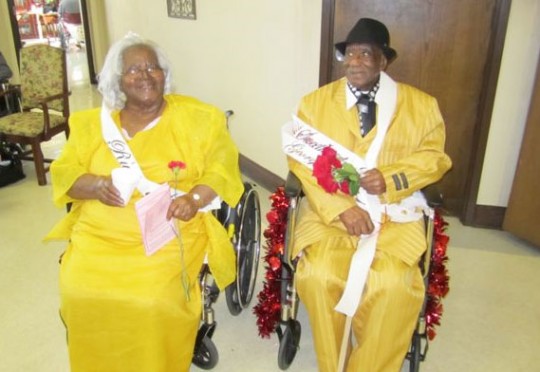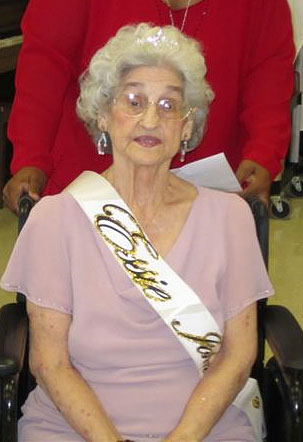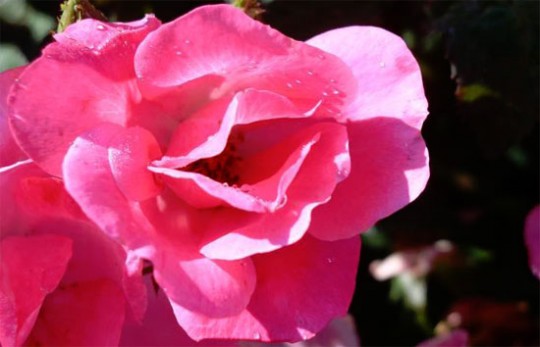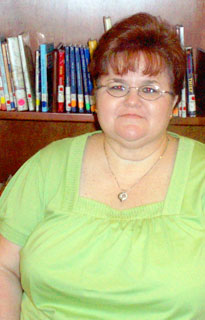Century Care Center: Be My Valentine
February 15, 2011
Residents at Century Care Center celebrated Valentine’s Day with a lot of good fellowship Monday afternoon.
Sweethearts were Evelyn Bates, Alene Burch, Hattie Floyd, Ada Inman, Ruby Leach, Essie Johnson, Dora Rolin, Betty Roney, Dorothy Roper, Ruth Steele, Thomas Barrow, David Comalander, Larry Gregory, George Lockett and W.E. Welch.
Submitted photos for NorthEscambia.com, click to enlarge.
Camp Fire Kids Create Valentine’s Cards For Vets (With Gallery)
February 14, 2011
The students at the Camp Fire USA Century Youth Learning Center shared their Valentine’s love with local veterans by making cards to express their honor and appreciation. Nationally, Camp Fire USA children and youth have made Valentine’s cards for veterans each year since 1978.
For more photos from the Camp Fire USA Century Youth Learning Center, click here.
Submitted photos for NorthEscambia.com, click to enlarge.
Featured Recipe: Fresh Rosemary Chicken with Pesto Pasta
February 13, 2011
This weekend’s featured recipe from Janet Tharpe is a Fresh Rosemary Chicken with Pesto Pasta. Fresh herbs, sun dried tomatoes and pesto sauce team with chicken for this impressive but simple pasta dish.
To print today’s “Just a Pinch” recipe column, you can click the image below to load a printable pdf with a recipe card.
Ernest Ward Holds Valentine’s Dance, Names Court (With Photo Gallery)
February 12, 2011
Ernest Ward Middle School held its annual Valentine’s Dance Friday night, naming a queen and her court based upon student votes.
Eighth grader Kamryn Brock was named queen, and TyDre Bradley was named king. From the seventh grade, Brianna Parker was named maiden, and Gavin Grant was named knight. Sixth grade maiden was Peighton Dortch and sixth grade knight was Hunter Kite.
For a photo gallery with the complete court, click here.
Pictured above: (L-R) Seventh Grade Maiden Brianna Parker and Knight Gavin Grant; Queen Kamryn Brock and King TyDre Bradley; and Sixth Grade Maiden Peighton Dortch and Knight Hunter Kite. NorthEscambia.com photo, click to enlarge.
Think Roses In February
February 12, 2011
 With Valentine’s Day just around the corner, out thoughts go to roses. Roses grown in Florida require regular maintenance, but growing roses can be a rewarding hobby for those who like to spend time in the garden each week. Pruning will help keep your plants healthy and productive.Hybrid tea and grandiflora roses, in particular, should be pruned every year during the first or second week in February. Otherwise, these roses tend to become leggy, less vigorous and unattractive, and they won’t bloom as well.
With Valentine’s Day just around the corner, out thoughts go to roses. Roses grown in Florida require regular maintenance, but growing roses can be a rewarding hobby for those who like to spend time in the garden each week. Pruning will help keep your plants healthy and productive.Hybrid tea and grandiflora roses, in particular, should be pruned every year during the first or second week in February. Otherwise, these roses tend to become leggy, less vigorous and unattractive, and they won’t bloom as well.
Other types of roses, such as floribunda, shrub and everblooming old garden roses, generally require less drastic pruning, but they still benefit from pruning to improve their shape or control their size, when necessary.
Following a logical sequence of steps while pruning will help make the job seem less complicated. The first step is to remove the three D’s: any dead, diseased or damaged wood. Cut the stems one inch below darkened areas, making sure you are cutting back to green wood. Make the cut at a 45 degree angle about ¼‐inch above an outward facing bud. If no live buds remain, remove the entire cane. Weak, spindly canes, which are the diameter of a pencil or less, should also be removed the same way.
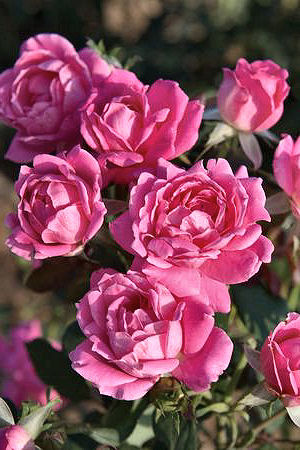 To avoid dieback and encourage rapid healing, pruning cuts should be made just above a dormant bud (eye). When an entire branch is removed, make a smooth cut at the point of juncture.
To avoid dieback and encourage rapid healing, pruning cuts should be made just above a dormant bud (eye). When an entire branch is removed, make a smooth cut at the point of juncture.
The second step is to remove branches that grow toward the center of the plant. This opens up the plant for better air circulation and allows sunlight to penetrate the inner portion of the plant. The third step is to locate crossing branches and remove the weakest one. Crossing branches may rub against each other, causing abrasions that may serve as openings for disease organisms to enter the plant. Also remove sucker growth, which is growth coming from below the bud union. Sucker growth can be from the root stock and a different rose variety; if not removed, sucker growth will crowd out the desired variety
Finally, prune to shape the plant. Hybrid teas, grandifloras and floribundas can be pruned 12 to 24 inches in height, leaving up to four to eight large, healthy canes the diameter of your finger or larger. Shrub and species roses should be pruned lightly, removing no more than 1/3 of the growth. Miniature roses need only minimal pruning. Old‐fashioned roses and climbers that bloom only once a year should be pruned
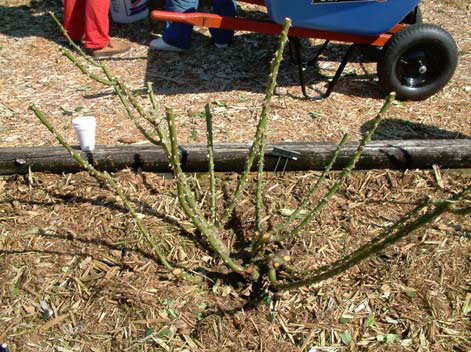 Immediately after flowering. Do not prune these types of roses heavily in the early spring since they bloom on wood from the previous year’s growth. If you have purchased new rose bushes you don’t have to worry about pruning them. Newly purchased roses have already been pruned, and no further pruning is required.
Immediately after flowering. Do not prune these types of roses heavily in the early spring since they bloom on wood from the previous year’s growth. If you have purchased new rose bushes you don’t have to worry about pruning them. Newly purchased roses have already been pruned, and no further pruning is required.
Pruning back roses takes some getting used to. Many new gardeners have a hard time getting up the nerve to cut their bushes back. If you don’t, however, the result will be tall, rangy, overgrown bushes that will not be nearly as attractive.
Theresa Friday is the Residential Horticulture Extension Agent for Santa Rosa County.
Short Lines As Verizon’s iPhone 4 Goes On Sale Locally
February 11, 2011
The much anticipated iPhone 4 debuted on the Verizon Wireless network on Thursday, with few customers lining up to be the first to get the smartphone.
“I just wanted to be one of the first ones because I’ve been waiting for a while for Verizon to get them,” said Lauren Cloud, a senior at Northview High School. She held ticket number two for the second iPhone sold at the Verizon store in Atmore (although she says she was the first to seal the deal and make it out the door).
For Cloud, it was a major upgrade from her old Droid Eris.
“I absolutely love it,” she said a few hours after moving from her old Google Android phone. Until Thursday, the iPhone 4 was available locally only on the AT&T network, which has somewhat spotty coverage in the North Escambia area.
 Customers across the U.S. braved inclement weather, lines or both at stores across the country to be among the first to purchase an iPhone 4 on the Verizon Wireless network. In Atmore, Cloud said there was a not a large crowd waiting for the phone when the doors of the store opened, but about eight people came in behind her.
Customers across the U.S. braved inclement weather, lines or both at stores across the country to be among the first to purchase an iPhone 4 on the Verizon Wireless network. In Atmore, Cloud said there was a not a large crowd waiting for the phone when the doors of the store opened, but about eight people came in behind her.
“I absolutely love it!”, Cloud said.
The iPhone 4 is available for $199.99 for the 16 GB model and $299.99 for the 32 GB model with a new two-year customer agreement.
Pictured top: Verizon customers across the country snapped up the new iPhone 4 on Thursday. Pictured inset: Northview senior Lauren Cloud seen in this mirror self portrait with her new iPhone 4. Courtesy photos for NorthEscambia.com, click to enlarge.
New Chinese Restaurant Opens In Century
February 11, 2011
The Century Area Chamber of Commerce held a ceremonial ribbon cutting Thursday afternoon, welcoming Happy Star to the neighborhood. The new Chinese restaurant has received rave reviews, according to the chamber. Happy Star offers a full menu for dine in or carryout.
Happy Star is located at 8321 North Century Boulevard, across from Whataburger. The store’s phone number is (850) 256-2258.
Submitted photo for NorthEscambia.com, click to enlarge.
Camp Fire Kids Sharing Valentine’s Love With Local Vets
February 10, 2011
 February is the month of love, and for the kids of Camp Fire USA Century Youth Learning Center, that love is being extended to local veterans.
February is the month of love, and for the kids of Camp Fire USA Century Youth Learning Center, that love is being extended to local veterans.
Every year since around 1978, Camp Fire USA children and youth have made Valentine Cards for local Veteran’s expressing their honor and appreciation. This tradition started as a call to citizens to volunteer at their local Veteran’s Administration hospitals or clinics. This call to action has become the National Salute to Veterans, observed during the week of Valentine’s Day.
Camp Fire USA is one of the nation’s leading not-for-profit youth development organizations, currently serving nearly 750,000 participants annually. For more information on Camp Fire USA Gulf Wind Council and the Century Youth Learning Center visit www.campfirekids.com. The Century location can be reached at (850) 256-0953.
Pictured: Camp Fire USA children across the area are making Valentine’s Cards for local veterans. Submitted photo for NorthEscambia.com, click to enlarge.
Mardi Gras Masquerade Planned
February 9, 2011
You can celebrate Mardi Gras and help the American Cancer Society at the same time later this month.
Century’s Relay for Life team will hold a Mardi Gras Masquerade on Saturday, February 26 from 7-11 p.m. at the town’s Ag Building on West Highway 4. The featured entertainment will be the Will Inspire Band, a local favorite group with previous appearances at the 2009 Century Relay and the Teaspoon Festival.
The event will include red beans and rice, photo opportunities and a silent auction. Attire is Mardi Gras formal or costume. This is an adults-only event, but no alcohol is allowed on the community center property.
Tickets are $20 per person. Businesses or individuals can reserve a table for eight for $150. Tickets are available from any Relay for Life Century team, the Century Branch Library or the Century Town Hall. Tickets are limited.
For more information, call (850) 256-3842.
Pictured above: The Will Inspire Band. Courtesy photo for NorthEscambia.com, click to enlarge.
Diane Kyser Named Bratt Elementary Teacher Of The Year
February 8, 2011
Diane Kyser has been named the 2010-2011 Teacher of the Year at Bratt Elementary School. The kindergarten teacher will be honored along with Escambia County’s other Teachers of the Year during the Golden Apple Awards in Pensacola on February 24. Courtesy photo for NorthEscambia.com, click to enlarge.


